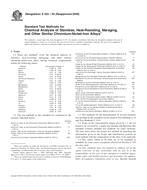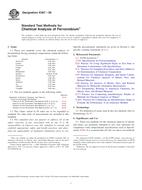Potřebujeme váš souhlas k využití jednotlivých dat, aby se vám mimo jiné mohly ukazovat informace týkající se vašich zájmů. Souhlas udělíte kliknutím na tlačítko „OK“.
ASTM D1971-11
Standard Practices for Digestion of Water Samples for Determination of Metals by Flame Atomic Absorption, Graphite Furnace Atomic Absorption, Plasma Emission Spectroscopy, or Plasma Mass Spectrometry
Automaticky přeložený název:
Standardní postupy pro trávení vodních vzorků pro stanovení kovů plamenové atomové absorpční, Graphite Furnace atomovou absorpční, Plasma emisní spektroskopie, nebo plazma Hmotnostní spektrometrie
NORMA vydána dne 1.4.2011
Informace o normě:
Označení normy: ASTM D1971-11
Poznámka: NEPLATNÁ
Datum vydání normy: 1.4.2011
Kód zboží: NS-18883
Počet stran: 6
Přibližná hmotnost: 18 g (0.04 liber)
Země: Americká technická norma
Kategorie: Technické normy ASTM
Kategorie - podobné normy:
Anotace textu normy ASTM D1971-11 :
Keywords:
digestion, flame atomic absorption spectroscopy, graphite furnace atomic absorption spectroscopy, inductively coupled plasma (ICP), metals, plasma-mass spectrometry , waste water, water, Dissolution, Dissolved elements (of water), Digestion, Flame atomic absorption spectroscopy, Graphite furnace atomic absorption spectrometry (GFAAS), Heating tests--chemicals/materials, Inductively-coupled plasma (ICP) spectroscopy, Metal content--water, Mineral acid dissolution, Plasma emission spectroscopy
Doplňující informace
| Significance and Use | ||||||||||||||||||||||||||||||||||||||||||||||||||||||||||||||||||
|
The determination of metals in water often requires the measurement of total (suspended and dissolved) metals as well as soluble (dissolved) metals. In such cases, consistent and dependable digestion procedures must be used so that data derived for the total metals content is reliable. The practices given are applicable to a wide variety of sample types for the purpose of preparing a sample for metals analyses by atomic absorption spectrophotometry or plasma emission spectroscopy (see Test Methods D1976, D3919, D4691, and D4190) or plasma-mass spectrometry (See Test Method D5673) and have been shown to give good recovery in the following matrices: industrial effluents; waste water treatment plant influents, sludges, dewatered sludges, and effluents; river and lake waters; and plant and animal tissues. Elements which have shown good recovery include: copper, nickel, lead, zinc, cadmium, iron, manganese, magnesium, and calcium. Good recovery for the indicated sample types and metals may not be achieved at all times due to each sample's unique characteristics. Users must always validate the practice for their particular samples. The analytical results achieved after applying these practices cannot necessarily be deemed as a measure of bioavailable or environmentally available elements. These three practices may not give the same recovery when applied to the same sample, nor will they necessarily give the same results as achieved using other digestion techniques. An alternate digestion technique is Practice D4309. |
||||||||||||||||||||||||||||||||||||||||||||||||||||||||||||||||||
| 1. Scope | ||||||||||||||||||||||||||||||||||||||||||||||||||||||||||||||||||
|
1.1 Most atomic absorption and plasma emission spectroscopy, and plasma-mass spectrometric test methods require that the metals of interest be dissolved in a liquid phase before being introduced into the spectrophotometer. These practices describe digestion or dissolution procedures whereby analyte metals associated with the solid fraction of a sample can be brought into solution for subsequent analysis. The following practices are included:
1.2 These practices have been demonstrated to be applicable to a wide variety of sample types and sample matrices, and in many cases, will give complete dissolution of the analyte metals of interest. They are by no means the only digestion procedures available. 1.3 The user of these practices should be cautioned that these practices may not completely dissolve all portions of a sample's solid phase and may not give complete recovery of the desired analyte metals. In these cases, other digestion techniques are available that will effect complete dissolution of a sample. It is the user's responsibility to ensure the validity of these practices for use on their particular sample matrix, for their metals of interest. 1.4 This practice assumes that the criteria established in Guide D3856 can be met. 1.5 These digestion procedures have been selected for their wide application, low cost, and ease of use. 1.6 The values stated in SI units are to be regarded as the standard. The values given in parentheses are for information only. 1.7 This standard does not purport to address all of the safety concerns, if any, associated with its use. It is the responsibility of the user of this standard to establish appropriate safety and health practices and determine the applicability of regulatory limitations prior to use. Specific hazard statements are given in Section 6. |
||||||||||||||||||||||||||||||||||||||||||||||||||||||||||||||||||
| 2. Referenced Documents | ||||||||||||||||||||||||||||||||||||||||||||||||||||||||||||||||||
|
Podobné normy:
Historická
1.6.2006
Historická
1.10.2009
Historická
1.10.2009
Historická
15.11.2013
Historická
27.1.2012
Historická
15.1.2010



 ASTM E353-93(2006)..
ASTM E353-93(2006).. ASTM E363-09
ASTM E363-09 ASTM E367-09
ASTM E367-09 ASTM E372-13
ASTM E372-13 ASTM E396-12e1
ASTM E396-12e1 ASTM E439-10
ASTM E439-10
 Cookies
Cookies
